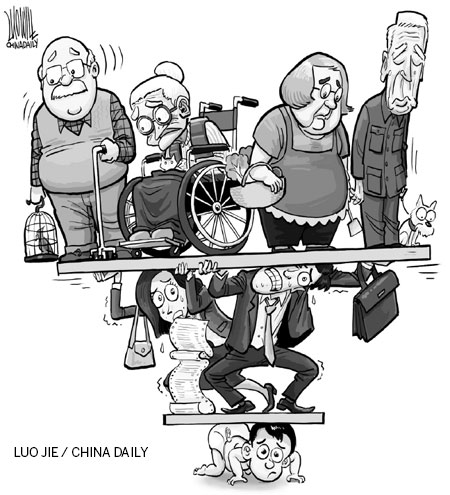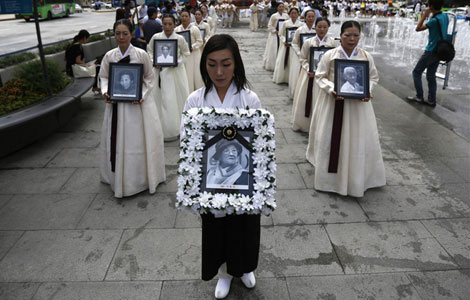Family policy deserves a rethink
Updated: 2013-08-15 08:07
By Mu Guangzong (China Daily)
|
||||||||

The National Health and Family Planning Commission has reiterated that even if the family planning policy were to be adjusted, it would not mean that couples could have a second baby if one of them came from a single-child family.
Nevertheless, it's time the authorities weighed the pros and cons of the family planning policy, which was implemented in the late 1970s to check population growth. There is no doubt that unchecked population growth in the 1980s and 1990s would have caused more harm than good to the families as well as to the country, because of the weak national economic foundation and already large population.
According to the current family planning policy, urban couples can have only one child. An urban couple can have a second child only if husband and wife both are from single-child families. In rural areas, though, couples have been allowed to have a second child if their firstborn is a girl. Ethnic groups other than Hans, on the other hand, have always been free to have two or more children.
The family planning policy has reduced the country's birth rate and curbed the rate of population growth, but it has also resulted in some harmful side effects, such as an imbalanced family structure, a skewed gender ratio, and an aging society.
Things have changed drastically since the late 1970s, so the authorities should give a serious thought to adjusting the family planning policy to suit the demands of the ongoing reform and opening-up.
In terms of happiness, social harmony and ideal population structure, a family should have two to three children, which is not possible in China under the present circumstances. But the authorities could, for example, allow couples to have a second child if one of them comes from a single-child family.
Contrary to what some people claim, this will not lead to a population boom, because the high cost of bringing up a child will dissuade a majority of such couples from having a second child. Besides, people's changed priorities because of the economic and social development of the past three decades will prevent many from having a second child. In particular, not many working women in urban areas would agree to undergo the trials and tribulations of labor twice all over. So even if the family planning policy is changed to allow more couples to have two children, not many families will avail of it.
In other words, although a change in the family planning policy may slightly increase the country's birth rate, it will not lead to a population boom. Instead, it could be an answer to China's current imbalanced population structure, aging population and waning demographic dividends.
Official data show that China had about 194 million people aged 60 years and above by 2012, which was 14.3 percent of the total population. Last year was also the first time when the percentage of working age population (aged 15-59) dropped, and going by statistical projections, China will lose its demographic dividends before 2030.
The country's population structure is like an inverted pyramid, with rising number of senior citizens at the top and shrinking number of youths at the bottom. As a result, senior citizens get to enjoy less and less social and family provisions, with parents who lost their only offspring when they were too old to have another suffering the most.
Allowing couples one of whom has no siblings to have a second child could ease, if not altogether solve, many of the above problems. Given the social and economic realities of the times, changing the family planning policy will help improve the family structure, increase provisions for the aged and promote harmony in society.
Moreover, "loosening" the family policy will curb the gender imbalance in China. Even though figures for the past three years suggest the gender ratio at birth has improved, the ratio is still 10 percentage points above the warning mark with newborn boys outnumbering girls by 10 percent.
Census data show that the gender ratio problem is still grave among adolescents and teenagers, and it is estimated that by 2020, China will have 24 million more men than women of marriageable age.
By allowing more families to have a second child, the authorities will help curb the gender imbalance, because then fewer couple will go in for illegal prenatal sex discernment tests of fetuses and female feticide.
To build a balanced population structure, the authorities have to take measures to gradually allow more couples to have a second child on a trial basis, and eventually move toward a two-child policy. And to establish an ideal population policy, the government has to fulfill some additional responsibilities of providing support for couples and improving welfare services.
The author is a professor of demography at Peking University.
(China Daily USA 08/15/2013 page12)

 Spielberg has desire to work with Zhang Yimou
Spielberg has desire to work with Zhang Yimou
 Requiem ceremony for former comfort woman
Requiem ceremony for former comfort woman
 Egypt forces crush protesters
Egypt forces crush protesters
 Two killed in fiery crash of UPS cargo jet
Two killed in fiery crash of UPS cargo jet
 Yao dreams of sports for fun with towering charity
Yao dreams of sports for fun with towering charity
 Re-enacting ancestors' journey to the west
Re-enacting ancestors' journey to the west
 Special bus seat for breast-feeding mothers
Special bus seat for breast-feeding mothers
 Northern exposure
Northern exposure
Most Viewed
Editor's Picks

|

|

|

|

|

|
Today's Top News
US asks China's help on DPRK issues
Movie tax flack is settled
Manning 'sorry' for US secrets breach
China to be world's No 1 consumer
Gold rises on physical buying from Asia
Millionaires hold dimmer view: Survey
China to probe foreign automakers
Snowden case not to affect US-Russia talks
US Weekly

|

|





